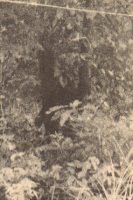The Earth shifted off its axis between 10-25 cm that day. Off the coast of Tohoku, Japan the Earth heaved at a magnitude 9.0 and thrust up a tsunami that stretched 40.5 meters (133 ft) high and traveled 100 mph. That is as high as the 4 towers surrounding the Taj Mahal. Honshu, the big island of Japan moved 8 feet. If that wasn’t enough the tsunami waves traveled all the way to Antarctica and broke off an iceberg the size of Manhattan.
That was the visible enemy.
The tsunami smashed into the Fukushima Daiichi Nuclear Power Plant and trashed the backup diesel generators used to keep the nuclear fuel rods cool. In the days and hours that followed, 3 reactors meltdown. We know a nuclear meltdown isn’t good, but what exactly is it anyway? It is when the nuclear fuel rods literally melt under their own heat. This heat then causes the containment sections of the reactor to melt and mix the radioactive material with coolant (usually heavy water). The result: BOOM! Well, not the boom of a nuke bomb. This is a boom caused by hydrogen explosions and what is called water hammer. Essentially a water explosion caused by pressure. The boom sends radioactive materials into the atmosphere in the form of fallout. This is exactly what happened at Fukushima.
 Tepco, the company running the plant, and the Japanese government scrambled to stop a complete meltdown. The workers at the plant did what they could – they even set up car battery blocks to power the reactor’s tracking systems. The Japanese government ordered the remaining reactors be steam vented to reduce the pressure on the containment; a suicide order. Workers over 40 years old volunteered to enter the radioactive hell scape of super heat and twisted metal to manually force open the release valves of the reactor. They succeeded, but it wasn’t enough.
Tepco, the company running the plant, and the Japanese government scrambled to stop a complete meltdown. The workers at the plant did what they could – they even set up car battery blocks to power the reactor’s tracking systems. The Japanese government ordered the remaining reactors be steam vented to reduce the pressure on the containment; a suicide order. Workers over 40 years old volunteered to enter the radioactive hell scape of super heat and twisted metal to manually force open the release valves of the reactor. They succeeded, but it wasn’t enough.
Several days ( and explosions) later. American nuclear scientists sent to assist Japan discovered at least one reactor was completely breached. Radioactive waste and fuel rods lay in a boiling pool of coolant. Once the coolant boiled away, the radioactive mess can leak into the air currents. In desperation, the Japanese government sent in Tokyo Firefighters. These firefighters 40 years old and over (they didn’t allow the younger ones to enter the plant – radioactive quickly sterilizes a man) came up with the plan. They parked a firetruck by the coast and ran hose up to the exposed fuel rods. These guys have no special training with radiation. They wore their fire suits and their radiation meters. They gave themselves one hour of exposure each team and simply did their job.
 The Tokyo Firefighters don’t receive anywhere near the same recognition as the Fukushima Fifty, the 50 workers who remained with the plant throughout the disaster, but their work stopped a complete radioactive catastrophe.
The Tokyo Firefighters don’t receive anywhere near the same recognition as the Fukushima Fifty, the 50 workers who remained with the plant throughout the disaster, but their work stopped a complete radioactive catastrophe.
What did they do after? Went home to their wives and kids.
Anyway, the firefighter’s efforts brought down the reactor’s temperature and radiation levels enough for Tepco to send in crews to pump in more seawater and begin some repairs.
The 12 miles around the Fukushimi Daiichi Nuclear Power Plant remain abandoned outside of escaped livestock and animals. Many animals starved to death after their caretakers fled. Many areas and residential districts will remain abandoned for decades to come. The fallout spread throughout that portion of Japan and will remain in the environment for many more decades.
The Japanese won against the invisible enemy, but the consequences of the fight will remain for the century to come.
Sources
- Inside Japan’s Nuclear Meltdown – Frontline
- Fukushima Daiichi Nuclear Disaster – Wikipedia
http://en.wikipedia.org/wiki/Fukushima_Daiichi_nuclear_disaster - 2011 Tohoku Earthquake and Tsunami – Wikipedia
http://en.wikipedia.org/wiki/2011_T%C5%8Dhoku_earthquake_and_tsunami - Japan Tsunami Breaks Off Antartica Iceberg the Size of Manhattan
http://tv.ibtimes.com/japan-tsunami-breaks-off-antarctica-iceberg-the-size-of-manhattan/1555.html
- Japan Faces Potential Nuclear Disaster as Radiation Levels Rise -New York Times
http://www.nytimes.com/2011/03/15/world/asia/15nuclear.html?pagewanted=all




